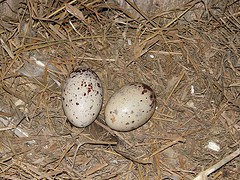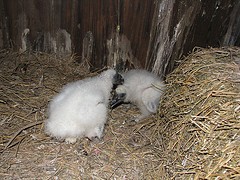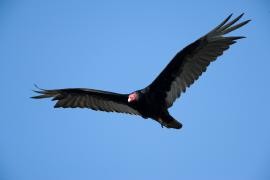Last spring, the live "eagle cam" feed from Decorah, Iowa blew up the Internets, making national news and entrancing millions of people in 184 countries who watched bald eagles hatch their eggs in real-time.
But this spring -- as you read this sentence, actually -- the folks behind that project are toggling their lenses around the nesting area of the eagle's ugly cousins: Turkey vultures in Marshall, Missouri.
"As far as I know, it's a first [for this species]," says Bob Anderson, director of Raptor Resource Project, an Iowa-based non-profit dedicated to protecting falcons, eagles, ospreys, hawks, and owls -- as well as their habitats. (Check them out on Facebook). And Anderson would know -- he's "been in the bird-cam world" for 20 years.
Normally, turkey vultures prefer to lay their eggs high up in cliff-sides or hollow trees. But in 2009, Chuck Hird, a retired meat-packer living in the town of Marshall, noticed that some vultures were nesting in the loft of his horse barn.
(Hird didn't know it yet, but this was an ideal spot to mount a bird cam, because a "mission control" could be set up only 400 feet away inside his house.)
For the first three years, Hird and his neighbor, John Carton, took only photos. They were so tickled by the new tenants that they sent the pictures to the Missouri Department of Conservation, who relayed the story to the Raptor Resource Project.
Anderson soon drove down to Marshall and installed a pair of silent cameras in the barn. One has an internal cooling system, infrared capability, and can move around by remote control.
"The cameras don't affect behavior at all because they're cryptic," Anderson says. "So we'll be writing the book of biology. We're going to learn a lot of things. I already have! I didn't know [turkey vultures] made a hissing or grunting sound."
Hird says that his vultures have only recently returned from winter migration. Right now, they're just dropping in and out during the day, and occasionally squabble with each other. No eggs yet, Hird reports, but adds that in the first week of May, the female will lay likely two eggs on the hay in the corner.
In years past, the neighbors tried to get pictures of adults feeding the hatchlings, but the adults were "too skittish" and always flew away. Now, with the hidden video camera, Hird and Carton will be able to observe such behavior. And it's up to them to manipulate the camera from Hird's computer room -- they're co-managers of the project. (They frequently phone each other if they see the birds are back from roosting).
CLICK HERE TO SEE THE LIVE "MISSOURI TURKEY VULTURES" FEED.
Turkey vultures don't elicit warm feelings from humans. First of all, their primary form of self-defense is
regurgitating semi-digested meat, a foul-smelling substance which deters most creatures intent on raiding a vulture nest. It will also sting if the predator is close enough to get the vomit in its face or eyes.And it doesn't help that they snack on freshly-dead things, like roadkill. (Some farmers think they kill young livestock, but that's untrue).
But turkey vultures are respectable in a sense: They locate carcasses through an uncommonly sharp sense of smell. That ability makes them "honest foragers," because they don't have to watch other birds to find carrion.
"A lot of people think they're ugly," says Bob Anderson. "But they're perfect flying machines. They just have to make a slight turn and they get lift. Turkey vultures have a singular beauty about them."








